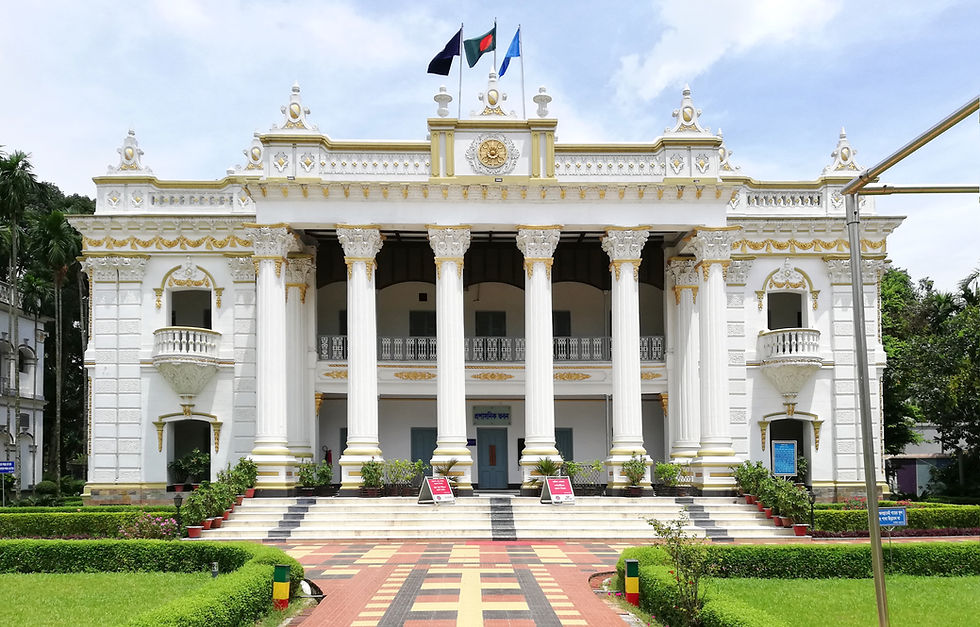Mughal Gardens & Caravanserais – Urban Heritage in Old Dhaka and Sonargaon
- Niharika Momtaz

- Oct 2
- 4 min read

The Mughal era in Bengal gave us more than just impressive forts and ornate mosques; it also shaped the look and feel of the cities with its carefully planned gardens and roadside inns. Piazza and rest area in one, these caravanserais hosted travelers and traders, and the gardens mixed business, rest, and beauty, all under the Mughal eye. Even though some of the sites are now cracked shadow images of their former glory, they still whisper stories about Dhaka and Sonargaon, two cities where the Mughal influence was unmistakable.
Mughal Gardens: Symbols of Power and Aesthetics
Drawing from Persian tradition, Mughal gardens were more than landscaping—they were miniature paradises, calling the lush comfort of heaven right to the earth. When Dhaka blossomed into Bengal's provincial capital during the 1600s, these greens were plotted as oases for the governors, wealthy nobles, and savvy merchants who ruled from the riverside. Mirroring perfect symmetry, they wound with sun-mirroring water channels, spouted sparkling fountains, and trees bursting with seasonal color. The gardens also cooled the stifling heat and doubled as discreet meeting halls for trade, court events, or leisurely chats.
The Charbagh layout, which carves a garden into four quadrants with a central water channel, became a hallmark of Mughal garden design. In Dhaka, the governors' palaces and garden mansions adopted this pattern, merging beauty with utility. These green spaces served more than an aesthetic purpose—they were living symbols of power, prosperity, and a conscious nod to Mughal visual culture.
Sonargaon, once the capital of Bengal's sultans and later a strategic Mughal outpost, was ideally suited to the Charbagh scheme. The garden's location along the Shitalakshya River provided a natural stage for cultivated wilderness. These gardens evolved into dynamic meeting places where merchants, local notables, and Mughal dignitaries exchanged news and trade, all beneath the shade of fragrant blossoms and the soft murmur of water.
Caravanserais: Commercial Heartlands
If the gardens were oases of calm, the caravanserais were the ever-taxed engines of trade. Positioned along Bengal's busy Mughal routes, the ones at Dhaka and Sonargaon were crucial ports of call for merchants transporting fabrics, muslins, and rice destined for Asian and European markets. The imperial authorities constructed elaborate caravanserais—fabulous central courtyards surrounded by rooms—where travelers and their pack trains could rest, store goods, and find the protection needed for the busy road ahead.
These caravanserais typically had a square or rectangular shape, with a central courtyard and arches lining the sides. Merchants safely stowed their crates, rested their pack animals, and caught their breath after weary miles. In busy seasons, the same caravanserais became informal marketplaces where trades were struck, ideas were shared, and cultures mixed in the shade of their portals.
Old Dhaka still retains echoes of Mughal caravanserais, although most have changed in purpose or shape. The grand Bara Katra and its smaller sibling, the Chhota Katra, are the finest survivors. Erected in the mid-1600s, they marry purpose and splendor, showcasing tall gates, chambers for rest, and delicate stone inlay. Both acted as markets and hotels, receiving visiting nobles as readily as merchants who called the lively capital home.
In Sonargaon, mid- and trans-continental traders found rest along the same veins of commerce. The remains of its caravanserais are less specific, but they still reiterate the region's role as a broker for Southeast Asian goods, echoing the bedrock of Mughal trade.
Urban Heritage and Social Life of Mughal Gardens & Caravanserais
Mughal gardens and caravanserais together wove a mixed-use fabric of leisure and livelihood. The gardens provided a breath of scent and shade, a platform for poetics and its chit-chat. At the same time, the caravanserais created round-the-clock vibrancy, knitting far-flung merchants into shared conversation. The two testify to an urban vision where repose, refreshment, and the clang of trade coalesced into a seamless, crime- and trade-free community fabric.
Socially, these spaces drew people together across class lines and regions. High-born guests strolled through ornate gardens, while enterprising merchants traded concepts and coins in bustling caravanserais. Visitors from Central Asia to far-off Europe tasted Bengal's heritage in these very locations. As a result, the sites became much more than impressive buildings—they transformed into living, breathing crossroads of culture.
Legacy and Challenges of Preservation
Currently, a significant portion of this heritage remains hidden beneath the weight of modern development. The rapid expansion of Dhaka's city limits has swallowed entire old gardens, and only remnants of caravanserais, such as the Bara Katra and Chhota Katra, still stand, often in a state of serious disrepair. Sonargaon, officially labeled a heritage zone, still faces the steady creep of settlement and disrepair.
Despite these threats, the importance of these places remains clear. They echo the era when Dhaka and Sonargaon welcomed ships and armies alike, a period of Mughal splendor and global exchange. Renewing and caring for these landmarks does more than protect the past; it strengthens our city's story, supports cultural visitors, and shapes a shared urban character.
Mughal gardens and caravanserais were a key part of old Dhaka and Sonargaon's city life, showcasing Mughal values such as balance, wealth, and the mingling of cultures. Today, their legacy continues to influence Bengal's history, teaching us about design, city planning, and community cohesion. When we cherish and guard these sites, we revive the worldly spirit that distinguished Bengal during the Mughal era.




Comments